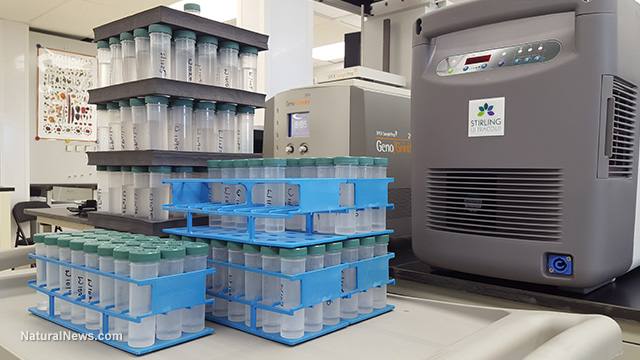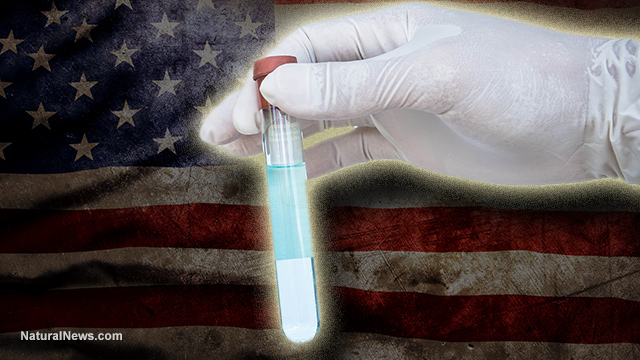
(NaturalNews) We've just finished testing the first 100 water samples we received from Natural News readers via our EPA Watch program to monitor the nation's municipal water supplies. Because the EPA knowingly lies about lead contamination in water -- and because state water testing agencies routinely commit scientific fraud to hide the truth about their water quality -- we have taken on the task of testing water for lead all across America.
Using our high-end analytical laboratory (CWClabs.com) and ICP-MS instrumentation running EPA methodology 200.8, we've just completed heavy metals testing the first 100 water samples we received. (Note: Heavy metals is just the first round of testing we'll be conducting. In another round, we'll be using the sample water samples to test for pesticides and other organic chemicals. Watch for that later...)
A full, detailed report of these water samples -- with details parts per billion results of the heavy metals detected in each water sample -- will be released here on Natural News within a week or so. Until that full report is released, here are some of the highlights of our ICP-MS analysis:
• NONE of the water samples contained any mercury at all. Not even a single part per billion. This isn't a mistake. We are 100% certain that all these tested samples contain near-zero mercury. (Not surprising, as mercury is not commonly found in municipal water supplies.)
• Out of 100 water samples, over 95% were below the EPA's current lead limit of 15 parts per billion. We found one alarming sample with lead showing 700% higher than the EPA limit, and we found 2-3 other samples with lead at about half the EPA limit. (See below for details on the alarming sample we found.)
• Cadmium levels were consistently low, as was arsenic, across nearly all samples.
• We did find some evidence of copper contamination, with some samples as high as around 400 ppb copper. The EPA limit on copper is 1300 ppb, and we didn't find any water samples even close to that. Nevertheless, I wouldn't want to be drinking 400 ppb copper on a daily basis, so we will point out the copper problems in our detailed report.
• Total dissolved solids in the water varied widely, and we confirmed very high levels of strontium in many samples (over 1000 ppb). There's no danger in this, by the way. Strontium is a nutritive mineral that often appears alongside calcium.
Here's a look at some of the water vials we prepped for analysis:
The most alarming sample we found out of these first 100 tested was a sample from a small town about 40 miles north of Phoenix, Arizona. The water in this sample tested at around 115 ppb lead, easily about 100 times higher lead levels than most other samples tested.
Because these water samples are crowdsourced, we cannot rely on any definitive conclusions from a single sample. So we are asking all residents living north of Phoenix to send us more water samples so that we can build more data points and possibly gather evidence of a lead contamination problem in the water there.
Click here to download the custody form that includes instructions for sending us water samples.
With your help, we might be able to identify another Flint, Michigan type of situation before it harms more children. Our aim is to bypass the corruption and incompetence of the EPA and publish our test results directly to the public in an open source format.
The next step for us is to format all the detailed ppb data into a downloadable PDF for public release. I'm going to include the ICP-MS calibration curves for full disclosure, so you can see our relative standard deviations (RSDs) and other scientific details on the instrument run.
The good news in all this is that most of the water samples we tested were very low in heavy metals. Out of 100 samples, we only found one "alarming" sample, plus a couple of others that might deserve some caution.
The fact that we did not find mercury, cadmium or arsenic in any alarming quantities in any of these water samples is comforting. It shows that many cities are apparently doing an adequate job in keeping toxic heavy metals out of their water. However, we haven't yet conducted tests for pesticides, pharmaceuticals and other chemicals, so there could be many more surprises yet to come.
For now, we encourage Natural News readers to send us more samples so we can build a more complete map of results. We are doing this as a public service -- at no charge to you -- and sharing these results publicly for the entire world to see. This is truly open source citizen science being conducted in the public interest, bringing transparency to a realm that has been hidden in government secrecy and corruption.
Learn more about this project at EPAwatch.org
Learn more: http://www.naturalnews.com/053623_lead_contamination_municipal_water_EPA_watch.html#ixzz45a3VspuW

(NaturalNews) Even as the contaminated water crisis in Flint, Mich., continues to make headlines, communities in three separate Northeast states have been facing a crisis of their own: widespread contamination of water supplies with the toxic chemical perfluorooctanoic acid (PFOA, or C8).
PFOA is one of the key ingredients in nonstick cookware and is also used in plastics, wax paper coatings and stain-resistant fabrics. It is a known toxin that accumulates and persists in the human body. Studies have linked PFOA with cancer and with immune malfunction in children.
"It stays in the body for many, many years, and it turns out to interact with processes in our body," said Harvard environmental health researcher Philippe Grandjean, as reported by NPR.
The story began in 2013, when a man named Michael Hickey began to wonder if his father's death from kidney cancer might be related to his job at a PFOA factory in Hoosick Falls, NY. Hickey worried about the plant's proximity to village wells, so he paid to have the well water tested.
The tests found PFOA levels above the Environmental Protection Agency's (EPA) safe threshold of 400 parts per trillion. Followup tests near the factory came up at 18,000 parts per trillion, 45 times the safe limit. In November 2015, the EPA said residents should stop drinking or cooking with local well water. That ban was recently lifted, but many residents have said they will stick with bottled water for now.
Just across the border in North Bennington, Vt., high PFOA levels were found in private wells near a former plastics factory. The soil around local homes tested at higher than 20 parts per trillion, the safe level set by the state Department of Health.
Communities in New Hampshire have also found high levels of PFOA contamination in recent months.
Unfortunately, the problem almost certainly goes far beyond these three Northeastern states. In recent years, PFOA manufacturers, including DuPont and 3M, have been sued for contaminating water in Alabama, Ohio and West Virginia. And the Pentagon is testing water at 664 separate military sites for contamination with PFOA used in firefighting foams.
"This is not just a local problem," Grandjean said. "This is a problem which I am sure occurs in every single state."
The Centers for Disease Control and Prevention says that 98 percent of the US public has detectable levels of PFOA in their blood.
In March, the governors of New Hampshire, New York and Vermont sent the EPA a letter, calling PFOA contamination "a national problem that requires federal guidelines and a consistent, science-based approach."
Unfortunately, the EPA has hardly been on the forefront of tackling this problem. The agency's supposedly "safe" threshold of 400 parts per trillion has been criticized as unscientific. When the standard was first passed, the Environmental Working Group accused the EPA of giving communities a "false sense of security."
The level was based on the belief that short-term exposure to PFOA in concentrations of 500 parts per trillion would cause no health effects.
"The fact is that there is no such thing as short-term drinking water exposure," EWG President Richard Wiles wrote in an open letter to the EPA administrator. "People drink tap water every day. PFOA persists in the environment, and thus in water supplies, for hundreds of years. ... Applying this short-term health advisory to long-term exposure to contaminated water directly contradicts both sound science and EPA's own principles of risk assessment and risk management."
In fact, a study conducted at the University of Pennsylvania found that drinking tap water containing 400 parts per trillion PFOA rapidly produced blood levels 10 times higher than the EPA's "safe" threshold.
Levels would almost certainly end up even higher, since most people are also exposed to PFOA daily from non-water consumer sources.
To find out how you can help citizen scientists test America's drinking water to improve water quality and protect public health, visit EPAwatch.org.
Sources for this article include:
NPR.org
NaturalNews.com
EPAwatch.org
Learn more: http://www.naturalnews.com/053617_tap_water_PFOA_chemical_contamination.html#ixzz45Zxlzdd0
Add This Forum To Your Favorites!
Challenge the message and not the messenger!
The first person to resort to name calling and personal attacks automatically loses the debate!
Personal attack is often the best indication that the writer knows his logic is flawed and therefore tries to deflect attention by attacking the opponent, instead of attacking the arguments of the opponent.
Forum Stats:
forum viewed 957,287 times
1,379 messages
129 topics
topics per page limited to: 8
average number of messages per page: 86
16 pages
CureZone Newsletter is distributed in partnership with www.netatlantic.com
Copyright 1999 - 2024 www.curezone.org